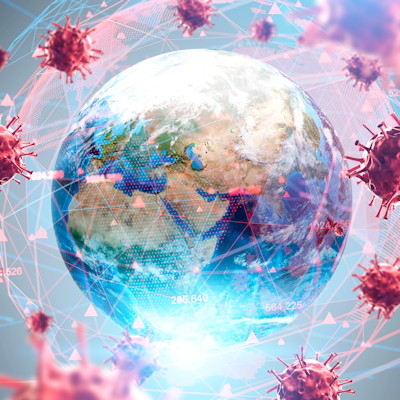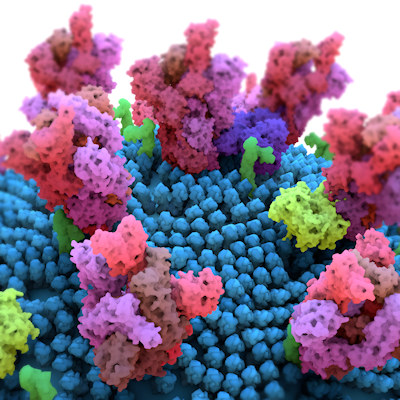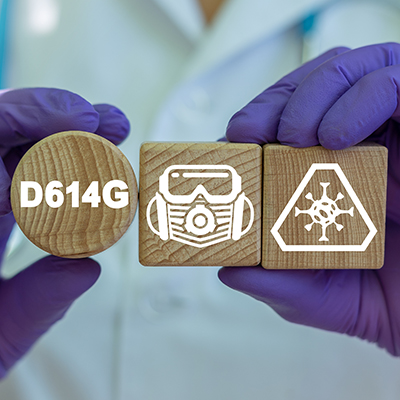November 25, 2020 -- In direct contrast to previous research, researchers found that SARS-CoV-2 mutations are not tied to increased transmissibility in humans. The findings, published in Nature Communications on November 25, suggest that mutations such as D614G, while common, are neutral to viral evolution.
Since SARS-CoV-2 jumped to the human population in late 2019, the virus has gradually accumulated mutations. These mutations can be used to track the spread of disease and to identify sites that may be under natural selection as the virus adapts to its new human host. Researchers around the world are continuously monitoring the genomic diversity of SARS-CoV-2 with a focus on the distribution and characterization of emerging mutations.
Mutations in RNA viruses arrive as a result of three processes and most are neutral, although some may be advantageous or deleterious. They can arise intrinsically by copying errors during viral replication, by the result of combination between two viral lineages co-infecting the same host, or by host RNA-editing systems, as part of host immunity. Detrimental mutations are often rapidly purged from the population while neutral and advantageous mutations can become more common in the viral population.
Early flagging of adaptive (advantageous) mutations can be useful to control viral spread. However, distinguishing neutral mutations (whose frequencies have increased through demographic processes) from adaptive mutations (which directly increase the virus's transmission) can be difficult. Most candidate mutations under natural selection are thought to have emerged repeatedly and independently in separate viral lineages (homoplasies).
It can therefore be insightful to test the potential effect of homoplasies on transmission, where transmission is considered a proxy for overall fitness. Differences in transmissibility between variants can be estimated using the relative fraction of descendants produced by an ancestral genotype.
The research team from the University College London (UCL), Cirad and the Université de la Réunion, and the University of Oxford, analyzed 46,723 SARS-CoV-2 assemblies to formally test whether any identified recurrent mutation is involved in altering viral fitness. The samples were collected across 99 different countries from all major continental regions.
Across the alignment, they detected 12,706 variable positions, which were heavily enriched with cytosine to uracil changes relative to other types of single nucleotide polymorphisms. Of these, around 400 were recurrent mutations within homoplastic sites.
The authors noted that mutations observed in the SARS-CoV-2 genome are not solely the result of errors by the viral RNA polymerase during virus replication but also action of human RNA-editing systems (e.g. activation-induced cytidine deaminase [AID; an enzyme] and apolipoprotein B messenger RNA editing enzyme, catalytic polypeptide-like [APOBEC; a protein family]), which have been implicated in innate and adaptive host immunity.
To test for an association between individual homoplasies and transmission, the researchers defined a phylogenetic index, called Ratio of Homoplasic Offspring (RoHO), designed to quantify the fraction of descendant progeny produced by any ancestral virion having acquired a particular mutation. The researchers found that 185 homoplasies met the RoHO score criteria of arising independently at least three times. None of these were statistically significantly associated with an increase in viral transmission for either tested alignment.
Most common mutations are neutral
All the recurrent mutations that the researchers identified seem to fit the expectation for neutral evolution with respect to transmissibility. The researchers suggested that these mutations are the best candidates for putative adaptation of SARS-CoV-2 to its novel human host. However, none of the recurrent mutations in circulation to date show evidence of being associated with viral transmissibility.
The D614G mutation (nucleotide position 23,403) emerged early in the pandemic and is now found at high frequency globally, appearing in 78% of the data set used in the current study. This mutation has been associated with increased transmission and virulence in previous studies. In the current study, the authors found that the D614G mutation is not associated with significantly increased viral transmission, which is in line with their other results.
The D614G mutation displayed only five independent emergences within the researchers' dataset. The low number of independent emergences indicates that the abundance of D614G is more probably a demographic artefact -- D614G went up in frequency as the SARS-CoV-2 population expanded -- rather than being a driver of transmission itself. This could be largely due to a founder effect (reduced genetic diversity in a population due to a small number of ancestors) originating from one of the earliest branches of SARS-CoV-2.
"Fortunately, we found that none of these mutations are making COVID-19 spread more rapidly, but we need to remain vigilant and continue monitoring new mutations, particularly as vaccines get rolled out," said first author, Lucy van Dorp, PhD, senior research fellow at the UCL Genetics Institute, in a statement.
The researchers cautioned that the imminent introduction of vaccines is likely to exert new selective pressures on SARS-CoV-2 to escape recognition by the host immune system. This may lead to the emergence of vaccine-escape mutants. The team's computational framework should be a useful tool for the timely identification of possible vaccine-escape mutations.
"The news on the vaccine front looks great," said Francois Balloux, PhD, lead author and professor at the UCL Genetics Institute. "The virus may well acquire vaccine-escape mutations in the future, but we're confident we'll be able to flag them up promptly, which would allow updating the vaccines in time if required."
Do you have a unique perspective on your research related to genomics or virology? Contact the editor today to learn more.
Copyright © 2020 scienceboard.net










